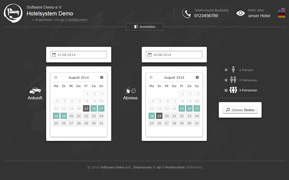Dokumentation
Inhalt
Einleitung
Über das System
Das ep-3 Hotelsystem ist eine Open Source Webanwendung (unter der MIT Lizenz) für Hotels und ähnliche Einrichtungen, welche es Gästen erlaubt, freie Zimmer online zu finden und zu buchen.
Das System war ursprünglich als Erweiterung des ep-3 Buchungssystems konzipiert, um dieses für den Einsatz in der Hotelbranche einsatzbereit zu machen. Es wurde jedoch schnell klar, dass ein solches System einen ganz anderen Aufbau erfordert als beispielsweise die Buchung von Tennisplätzen.
Daher wurde das Hotelsystem vom Buchungssystem abgespalten und zu einem eigenständigen Projekt ernannt. Dadurch konnte die Software speziell auf die Bedürfnisse der Hotelbranche zugeschnitten werden.
Übersicht
Hauptfunktion und -prozess des Hotelsystems sieht folgendermaßen aus:
- Das System für das eigene Unternehmen einrichten (Namen, Texte, Einstellungen, ...)
- Zimmer erstellen und einrichten (mit Texten, Bildern, Kapazitäten, ...)
- Pakete mit Preisregeln für Übernachtungen und zusätzliche Produkte und Dienstleistungen erstellen
- Gästen die komfortable Buchung und Auswahl von Produkten ermöglichen ...
- ... und die Buchungen und Rechnungen über die Verwaltungsoberfläche bearbeiten.
Features
Einen Überblick über die derzeit vorhandenen Features des Systems bietet die Seite Funktionen.
Außerdem befinden sich weitere fortgeschrittene Features in der Planung bzw. Entwicklung, wie z.B. verschiedene Zahlungsmöglichkeiten, die optionale Anmeldung von Gästen, um Buchungen einzusehen und den Buchungsprozess zu beschleunigen, sowie Mitarbeiter-Zugänge für die Verwaltungsoberfläche.

